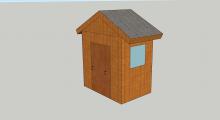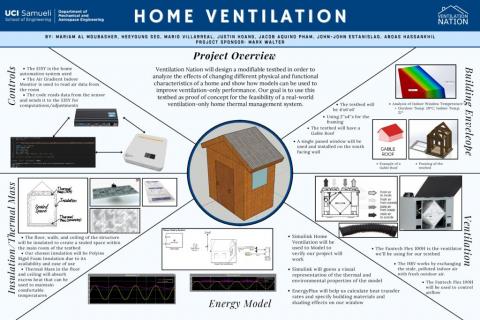Home Ventilation
- Background:
Our project sponsor, Mark Walter, has participated in the sustainability decathlon and is highly interested in the field of net zero (no emissions) living. Such a technology is extremely disruptive in a market that is dominated by fossil fuel consumption, thus our project work could provide a foundation for fellow engineers to build upon. The underlying motivation for this project is to further the initiative towards sustainability; particularly working towards zero carbon emission living by removing heat pumps,boilers, etc. and maintaining comfortable standards of living.
- Goal and Objectives:
-
February 1, 2024: Problem Definition Presentation
-
The goal here was to have a defined and tangible problem to tackle. The objectives were:
- Stakeholder Needs & Specific Requirements
- Timeline of the Quarter (Gantt Chart)
- Listing Design Attributes in an OCFM Table
- Grey Box creation for functional decomposition of project subsystems
-
The goal here was to have a defined and tangible problem to tackle. The objectives were:
-
February 15, 2024: Preliminary Design Review
-
We were tasked with proposing a design after final concept selection. The main objectives were:
- Energy Model Design in SketchUp
- SolidWorks Model of the testbed foundation/structure
- Subsystem Table breaking down project areas
- List of Key Design Components
-
We were tasked with proposing a design after final concept selection. The main objectives were:
-
After Winter Design Review, the final goal of the quarter will be Proof of Concept. The objectives are as follows:
-
Constructing a miniature box wrapped in OX-IS, with a lamp placed directly over the prototype.
- We want to quantify the ability of the insulation to resist heat flow, be able to turn the lamp on and off with our home automation system, and measure the temperature within & outside of the prototype using sensors
-
Plug the FLEX100H HRV system into an outlet at home and allow it to run for a short duration of time.
- We will be collecting data of the heat recovery effectiveness and comparing this to the listed effectiveness on the HRV manual. Given a certain outside temperature and indoor temperature, we can measure the intake/outtake air temperatures.
-
Create a digital replica model of the prototype in Energy Plus and Simulink
- This will serve as proof that there can be quantitative results and give specific benchmarks that can be met when testing the physical prototype.
-
Constructing a miniature box wrapped in OX-IS, with a lamp placed directly over the prototype.
-
Project Sponsor:
- Mark Walter m.walter@uci.edu
-
Team Contact(s):
- Aboas Hassankhil aboash@uci.edu
- Mario Villarreal mvillar3@uci.edu
- Mariam Al Moubasher malmouba@uci.edu
- Heeyong Seo heeyongs@uci.edu
- Jacob Aquino Pham phamja2@uci.edu
- John-John Galeon Estanislao jestanis@uci.edu
-
Justin Duong Ton Hoang hoangjd2@uci.edu
Project status:
Active
Department:
MAE
Term:
Winter
Spring
Academic year:
2023-2024


